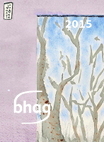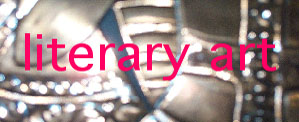b h a g . n e t visual and conceptual exchange b h a g . n e t


bhag cover page
bhag literary art
S. E. Chambers literary art
ANNA LEA MERRITT'S "LOVE LOCKED OUT"
Art, from the beginning, endeavored to express emotions and historical facts to be understood by all human souls of all nations, without need of written words. Art uses the gestures of human beings, the atmosphere of the universe to convey thought and emotions and to record events. Without thought and emotions, it has no reason for existence.—Anna Lea Merritt
At first glance, the painting seems a distant, fleeting memory. The warm colors, the torn emotional state, cause me to be fixed in my position. I have to force myself away from the painting, or I would be lost forever.
On a cold autumn sunrise, a nude androgynous figure, symbolizing Love, is desperately trying to get into a locked door. The burnt-out lantern on the floor shows that the figure has been trying throughout the night. The figure is slumped over with grief and fatigue. As seen by the positioning of the arms and the head, the figure has lost the battle. In the next gesture, the figure leaves the door and slowly walks away with slumped shoulders and lowered eyes.
The title of the painting, "Love Locked Out", and the stance of the figure connect the viewer with Love and with the intense longing to be inside and the loneliness of being locked out. In fact, many viewers might see the entire composition as a symbol of forbidden love, instead of "Love...waiting for the door of death to open and the reunion of the lonely pair" (Merritt, 164).
Anna Lea Merritt was born in the year 1844 and raised in Philadelphia, Pennsylvania. She began to receive drawing lessons at the age of seven (Dunford, 220). As a young woman, she was barred from attending the academies. Thus, she moved to Europe where she found willing art instructors. In Europe, she met, fell in love with, and married her art teacher and critic, Henry Merritt, in the year 1877 (see www.brooklynart.org and Dunford, 220). Tragically, he died three months later (Lambourne, 319). The painting "Love Locked Out" was a dedication to her husband, according to her memoirs of the same title. She wrote, "the closed door is the door of the tomb" (164). Originally, the artwork was meant to be a bronze sculpture relief for their joint tomb. Instead, she chose to invest her emotions into a painting. The painting was completed in 1889 and purchased by the Tate Gallery (Dunford, 220).
The painting "Love Locked Out" possesses characteristics of the ideal beauty and picturesque and tragic symbolism of Romanticism. In late nineteenth century England, the nude figure had a double meaning: One being aesthetic advancement and the other being a sign of moral decay (www.brooklynart.org). Also during this time, an exhibition of a woman's artwork was hard to accomplish. Merritt commented on exhibiting in a letter to artists, published in Lippincott's Monthly Magazine in March 1900, that recent attempts to make separate exhibitions of women's work were in opposition to the views of the artists concerned, who knew that it would lower their standard and risk the place they already occupied (Merritt, 236).
Despite these hardships, she was a prominent woman among her contemporaries. She continued to produce and exhibit her artworks at the Royal Academy and elsewhere until she died in 1930. According to Penny Dunford, in her final years, "she was elected a member of the Royal Society of Painters and Etchers, painted a mural for a Surrey church and executed numerous portrait commissions" (Dunford, 220). Merritt spoke in a positive manner about the roles of an artist in society and the difficulties of being both a woman and an artist. She felt optimistic about the academic institutions of her day. She stated: "The only complaint we have in England, and we never speak of it, is that no one of us has been elected to the Academy, even in an honorary degree, but when a lady comes whose art is unmistakably deserving of this distinction I do not believe it will be withheld" (Merritt, 236).
Anna Lea Merritt's painting "Love Locked Out" should have granted her this distinction because of her mastery of the nude and of symbolism. Love is a universal theme which gives the painting an impact far-reaching across the centuries.
references
Brooklyn Museum of Art. "Exposed: The Victorian Nude". http://www.brooklynart.org [20 October 2002].
Dunford, Penny. "Merritt, Anna. Nee Lea (1844-1930)" in A Biographical Dictionary of Women Artists in Europe and America Since 1850. New York: Harvester Wheatsheaf, 1990.
Merritt, Anna Lea. Love Locked Out: The Memoirs of Anna Lea Merritt with a Checklist of Her Works. Boston: Museum of Fine Arts, 1981.
"Women Artists" in Victorian Painting. Edited by Lambourne. London: Phaidon Press Limited, 1999.
© 2002 S. E. Chambers